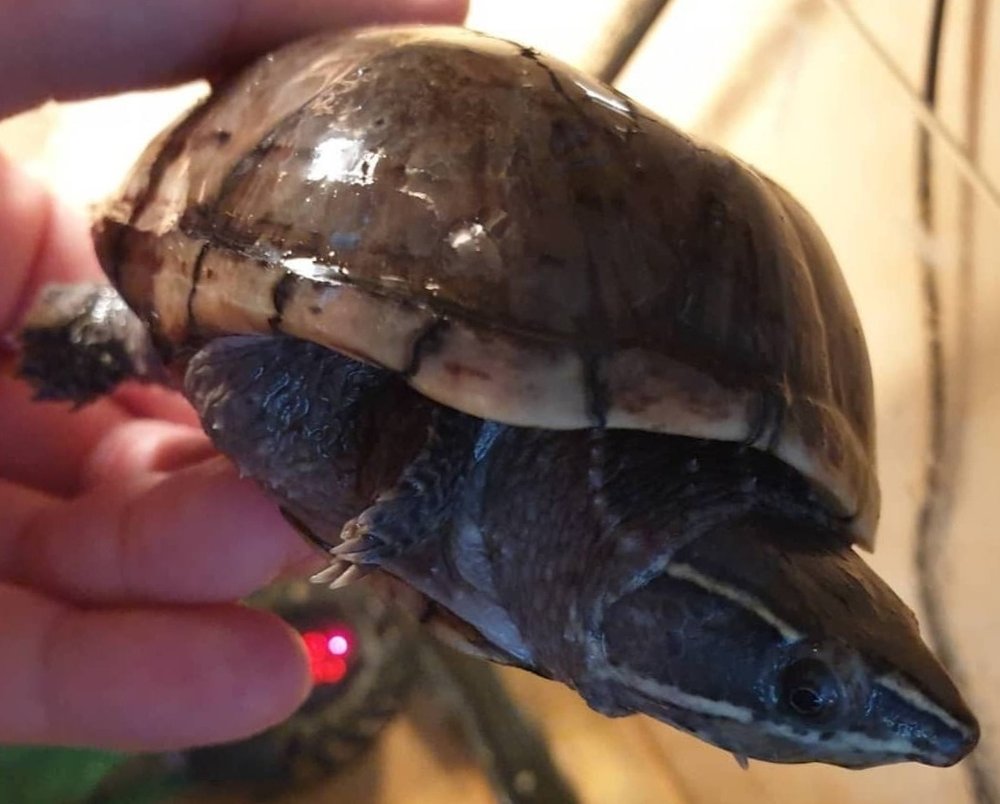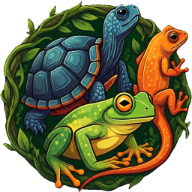
Sternotherus odoratus
The musk turtle (Sternotherus odoratus) originates from the eastern and southeastern United States. It is a small aquatic turtle, commonly referred to as the “stinkpot.” They typically grow to about 15 cm and can live up to 40 years. Their shell is high and dome-shaped. In fact, they are not particularly good swimmers; they often walk along the bottom in search of food. They can extract oxygen from the water with their tongue, allowing them to stay submerged for extended periods.
The musk turtle is diurnal. They are naturally found in slow-moving rivers. You can find them in lakes and swamps. Musk turtles that are startled or become stressed can release a foul substance from their scent glands as a defense. This can deter potential predators.
Enclosure
Musk turtle are solitary animals. Therefore, it is best to house them alone. Housing them together can lead to fighting and may eventually result in death. Turtles feel most comfortable when they are alone. Just because they tolerate each other doesn't mean they enjoy the company.
Fish are often kept with turtles, but keep in mind that fish are on the menu, so there is a risk of them being eaten. Make sure to add fish that do not contain thiaminase. You can add aquatic plants to the terrarium, but there is a good chance they will be eaten or disturbed. Water plants such as Elodea, duckweed, or hornwort are safe.
In the summer, when outdoor temperatures allow, you can temporarily house your turtle in a pond. This often occurs between May and October. Be mindful that goldfish contain thiaminase; if your pond has goldfish, it is better not to house your turtle there. The turtle must also be able to come ashore, and the pond should have good fencing, as they are adept escape artists.
The terrarium should be at least 100x50x50 cm for one animal. It should include a basking island for the turtle. The water depth must be at least twice the length of the turtle. Sand is the best substrate, as they can search for food safely among it. Gravel or larger stones can pose a choking hazard. Ensure that decorations are stable so they do not trap the turtle underneath.
Temperature & Humidity
The water temperature for a young animal should be set at 26 degrees Celsius. For an adult animal, it can be reduced to 23 degrees. The temperature under the lamp should reach 30 degrees. It is advisable to incorporate a background wall in the terrarium as this contributes to stress reduction. Additionally, they require a day and night cycle of approximately 10-12 hours of light per day, which can be managed by adding a timer. A lock is useful to ensure that children cannot access the terrarium.
To keep the water clean, an external aquarium filter must be installed. Turtles are significant polluters, so an external filter is essential. The water flow should not be too strong. There should be no heater in the water, as higher water temperatures than the surrounding air can lead to respiratory infections. Above the basking area, a heat lamp should be placed so they can sunbathe. Ensure that the turtle cannot reach the heat source to avoid burns.
If keeping a female turtle, an island with at least 10 cm of sand is necessary where she can bury her eggs. UV light is recommended, as it enhances calcium absorption. Reptiles produce vitamin D3 in their bodies thanks to UV light, which is necessary for calcium uptake. They do not require excessive UV exposure. A UV lamp should be replaced once a year.
Care & Handling
Reptiles are primarily animals for observation, not for cuddling. If you need to move your animal, for instance for a health check, grip it firmly at the back of the shell. A turtle should never fall; they can break their shell and die as a result. It is also advisable to wash your hands before and after handling. Half of the water should be replaced once a week. Turtles are significant polluters; an accumulation of toxins can lead to many problems.
Food & supplements
Musk turtles are primarily carnivorous. You can provide them with dry food in the form of pellets or a turtle mix. A varied diet is important as it contributes to the health of your reptile. Live fish food such as tubifex, mosquito larvae (red, white, and black), and earthworms are good to offer occasionally. Insects like crickets or grasshoppers can be given from time to time as well. They also enjoy some vegetables and fruit occasionally.
In this care sheet, you will find a list of suitable and less suitable food for your turtle. Meats such as fish, chicken, mussels, or beef heart are also very appealing to them. When it comes to fish, be aware that they should not contain thiaminase; heating makes it harmless. The food should be dusted with calcium and vitamins. Calcium is essential for strong bones, and vitamins contribute to the overall health of your reptile. This application is never simultaneous; provide vitamins once a week and calcium on the other days.
There should always be a piece of cuttlefish bone in the water, which is a source of calcium for reptiles. Feed your juvenile turtle small amounts 1-2 times a day. Adult turtles can eat 3 times a week, and any uneaten food should be removed within 5 minutes.
Conclusion & Difficulty
In conclusion, it can be stated that they are indeed very small turtles that are exceptionally well suited for being kept in fairly small enclosures. This characteristic makes them a good choice for most homes, especially those with limited space. They are remarkably hardy reptiles, which contributes to their popularity among enthusiasts. Because of this resilience, they are often rated with the following difficulty level.
Difficulty 1 out of 5.
